-
solutinos
-
Hire
Frontend Developer
Backend Developer
-
NodeJS Developer
-
Java Developer
-
Django Developer
-
Spring Boot Developer
-
Python Developer
-
Golang Developer
-
Ruby on Rails Developer
-
Laravel Developer
-
.NET Developer
Technology
-
Flutter Developer
-
React Native Developer
-
Xamarin Developer
-
Kotlin Developer
-
Cross-Platform Developer
-
Swift Developer
-
MongoDB Developer
-
C Developer
-
Smart Contract Developers
Cloud
-
-
Services
Mobile Development
Web Development
- Work
-
Multi Services App
-
Food Delivery App
-
Grocery Delivery App
-
Taxi Cab Booking App
-
Multi Services App
-
OTT Platform APP
-
Social Media APP
-
Freelance Service App
-
Car Rental App
-
Medicine Delivery App
-
Liquor Delivery App
-
Sports Betting App
-
Online Coupon App
-
eLearning App
-
Logistics & Transportation App
-
Courier Delivery App
-
On-Demand Real Estate App
-
E-Wallet APP
-
Online Dating App
-
Handyman Services App
-
-
Process
-
Company
.jpg)
So, you see the gradual evolution in our series, right? We started off with one of the most conventional business models to exist – Multi-Brand Retail Store – and then gradually moved on to dropshipping, wholesaling and warehousing. We then discussed some of the contemporary business models to stem out of the birth of the internet such as freemiums and subscription-based models.
Both took the essence of conventional models and added digital aspects to become more airtight business models. In this post, we are going to cover one of the most recent models that has managed to strike a chord among the masses and help us out during one of the darkest pandemics of our times – online marketplaces.
Let’s understand what online marketplaces are, their challenges and fixes so by the end of the post, you know how to run a successful online marketplace.
What Are Online Marketplaces?
Online marketplaces are digital avenues that allow customers to explore their preferred products and purchase them. If you are new to this, simply visualize a local (offline) marketplace, where sellers from different places come together and offer a spread of their products and customers are free to look around and then finally decide what to purchase.
Now, take this visualization and add a digital layer to it. Instead of physical real estate, imagine an Ecommerce store. Sellers become vendors while customers are king as always. In this business model, you integrate a payment gateway on your website so your customers could pay for their preferred products or services.
One of the major differences between an online marketplace and a multi-vendor store is that in the former, vendors offer their goods or services on your platform for the traffic and sales your brand promises. On the other hand, you procure products from different labels in a multi-vendor store and are responsible for the sale of each.
As an online marketplace business owner, you make money from multiple resources –
- A cut on every sale made through your website
- Fees such as transaction or handling charges levied on customers
- A cut from your vendors
- Advertisement and sponsored products or services and more
Types of Online Marketplaces
IOnline marketplaces can be classified into three types –
- Online marketplaces for products
- Online marketplaces for services
- And virtual marketplaces
Now, each of the above-mentioned marketplace categories can be further classified into distinct wings. Here is a flowchart to help you understand better.
.jpg)
Single-vendor Marketplaces
Any marketplace that sells products or services from just one vendor. In this model, one you have one marketplace in the form of an app or a website and you have only one vendor that sells a product or service specific to its brand. There are only two parties involved in this model - the buyer and the seller. Such marketplaces are also known as standalone websites. This could be a food and beverage chain, an apparel boutique or more. For example: Pizza Hut
Multi-vendor Marketplaces
Any marketplace that sells products or services from more than one vendor is called a multi-vendor marketplace. Unlike single-vendor marketplaces, this involves three parties - the owner who takes up the role of an administrator of the website/app and the business, the buyer and the vendors (multiple). Customers checkout a multiple-vendor marketplace to explore multiple options in terms of brands, pricing, range and more. Vendors, on the other hand, tie up with such marketplaces to sell more products/services, acquire new customers, keep their inventory moving and make profits. All vendors need to register on the marketplace to sell their products, which involves a set of prewritten procedures such as onboarding, verification and more. For example: Amazon, Alibaba, Udemy
Peer-to-Peer Marketplaces
Any marketplace that allows consumers to sell their products or services to other consumers directly is called a peer-to-peer marketplace. The purpose of such a marketplace is very similar to that of a multi-vendor marketplace but the major difference here is that the sellers here are not vendors but individuals. So, anyone who signs up experiences a different registration process, where they can post requirements and sell products or services as well. For example: eBay and the classifieds marketplace.
Virtual Marketplaces
An umbrella term for marketplaces for distinct services or products such as films, music, publishing, video games, books, magazines and more. Virtual marketplaces are avenues for businesses to sell anything unique and specific to customers. From marketplaces that offer legitimate video games, music and eBooks to publications of magazines, journals and more, virtual marketplace includes everything. The registration process is different in the fact that it might involve licencing as royalties are involved in the selling process.
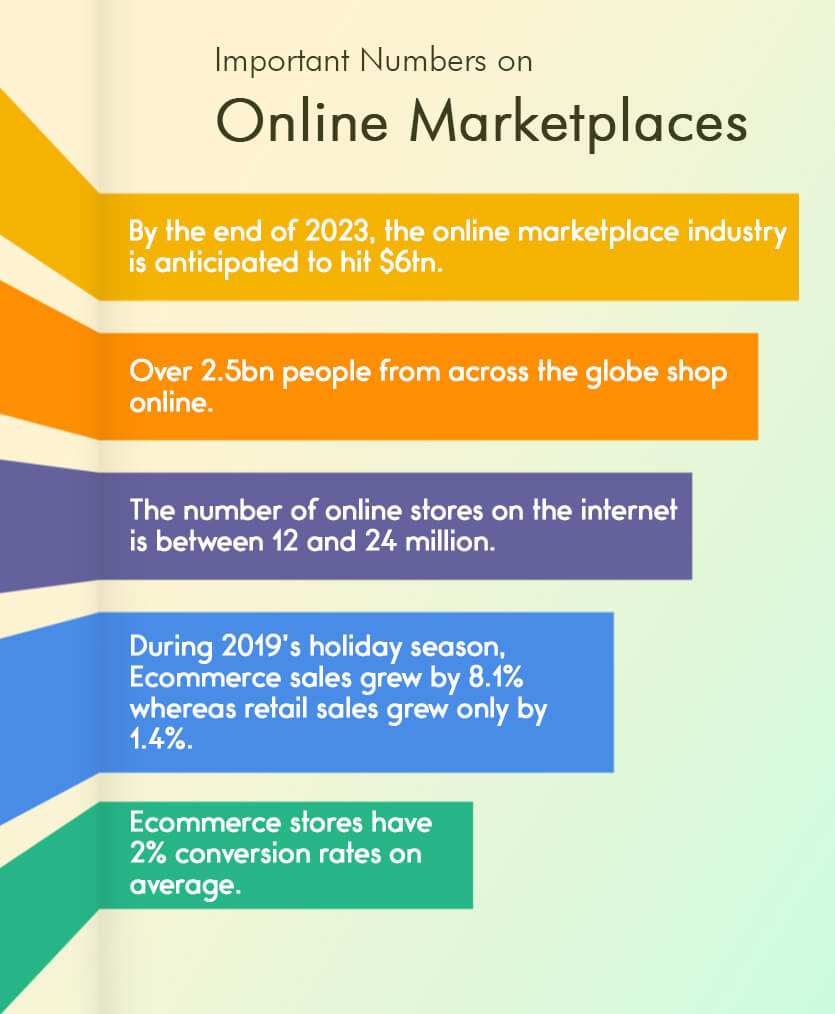
Important Numbers on Online Marketplaces
- By the end of 2023, the online marketplace industry is anticipated to hit $6tn.
- Over 2.5bn people from across the globe shop online.
- The number of online stores on the internet is between 12 and 24 million.
- During 2019’s holiday season, Ecommerce sales grew by 8.1% whereas retail sales grew only by 1.4%.
- Ecommerce stores have 2% conversion rates on average.
Advantages of Online Marketplaces
One of the best advantages of online marketplaces is the fact that it is comparatively easier to start an online business than a conventional one. This is immensely because of the limited expenses involved in starting up – an app or a website, promotions and a solid supply-chain model.
Apart from this, there are several advantages marketplace owners experience. Let’s look at some of them.
- Online marketplaces are ideal avenues to generate a steady flow of income.
- With the help of a really good app or an Ecommerce website, business owners can understand their target audiences better.
- Personalized deals, discounts and recommendations are key advantages offered by online marketplaces.
- Several redundant tasks can be automated including supply-chain.
- It’s a scalable business model, where you can grow up and down based on your needs.
Challenges In Online Marketplaces
Remember the flowchart we saw earlier? The challenges faced by you as an online marketplace owner completely depends on what type of business you run. Meaning, if you have a single-vendor marketplace, your challenges and hurdles would be very different from what a multi-vendor marketplace owner or a peer-to-peer business owner would experience.
To help you understand better, we have classified the challenges accordingly.
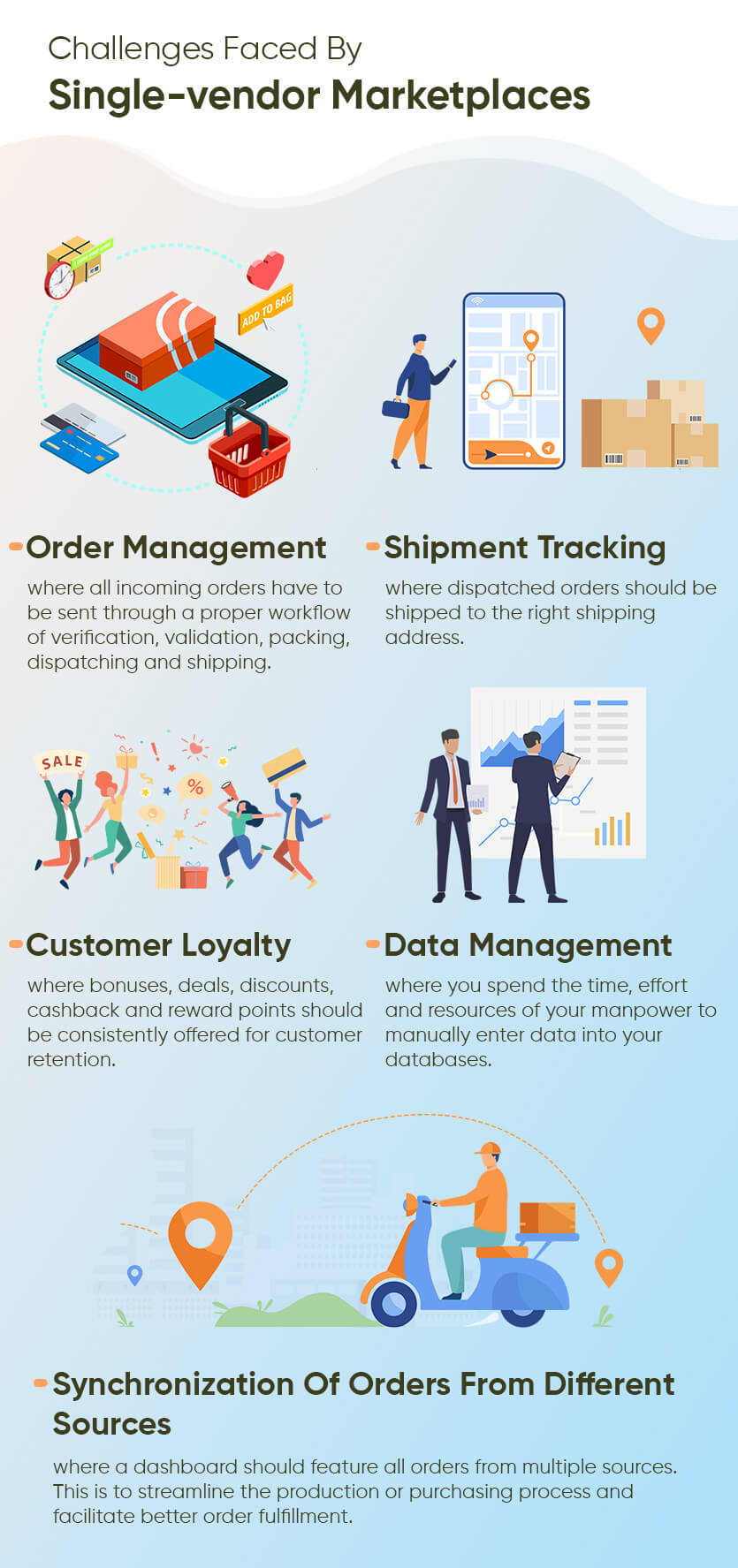
Challenges Faced By Single-vendor Marketplaces
Like we saw, a single-vendor marketplace is where you sell products or services of just one vendor. Imagine the website of Domino’s Pizza or KFC for that instance. Regardless of where you are in the world, you get food and beverages specific only to Domino’s Pizza or KFC. However, variations of them depend on the region you are in.
Just like your food and beverage marketplace, a single-vendor marketplace could be for apparel, electronic and electrical devices, groceries, books, music, online courses and more.
The distinct challenges faced by single-vendor marketplaces are here:
Order Management : where all incoming orders have to be sent through a proper workflow of verification, validation, packing, dispatching and shipping.
Real-world Scenario : If you own a single-vendor apparel store, any online order you receive should immediately reflect on your dashboard so that you could process the order immediately. Depending on your supply-chain process, you could either automate it or notify manually. Any glitch in this process could lead to bad reputation and lost business as most customers pay upfront.
Shipment Tracking : where dispatched orders should be shipped to the right shipping address.
Real-world Scenario : often, billing addresses are different from shipping addresses. Your POS should be able to differentiate between the two and schedule shipment delivery to the right address. All special instructions such as gifting options and cards should be fulfilled as well. A tracking ID should be shared with customers for real-time notification.
Customer Loyalty : where bonuses, deals, discounts, cashback and reward points should be consistently offered for customer retention.
Real-world Scenario : Your customers would be more interested in coming back to your marketplace for more shopping when they get rewarded something. Depending on your business, you could figure out what works best and implement. This is possible only when you have a solid app or website in place.
Synchronization Of Orders From Different Sources : where a dashboard should feature all orders from multiple sources. This is to streamline the production or purchasing process and facilitate better order fulfillment.
Real-world Scenario : If you own an apparel store, you could be getting orders from your own ECommerce store, Instagram handles, Amazon or other sources. Regardless of the source of the order, your dashboard should collate all orders for your dispatching team to work on the order, pack it and send it.
Data Management : where you spend the time, effort and resources of your manpower to manually enter data into your databases.
Real-world Scenario : Apart from being time-consuming, this process is also tedious and subjected to errors and risks. The deletion of a single cell in your spreadsheet can modify crucial details like addresses or contact details dramatically.
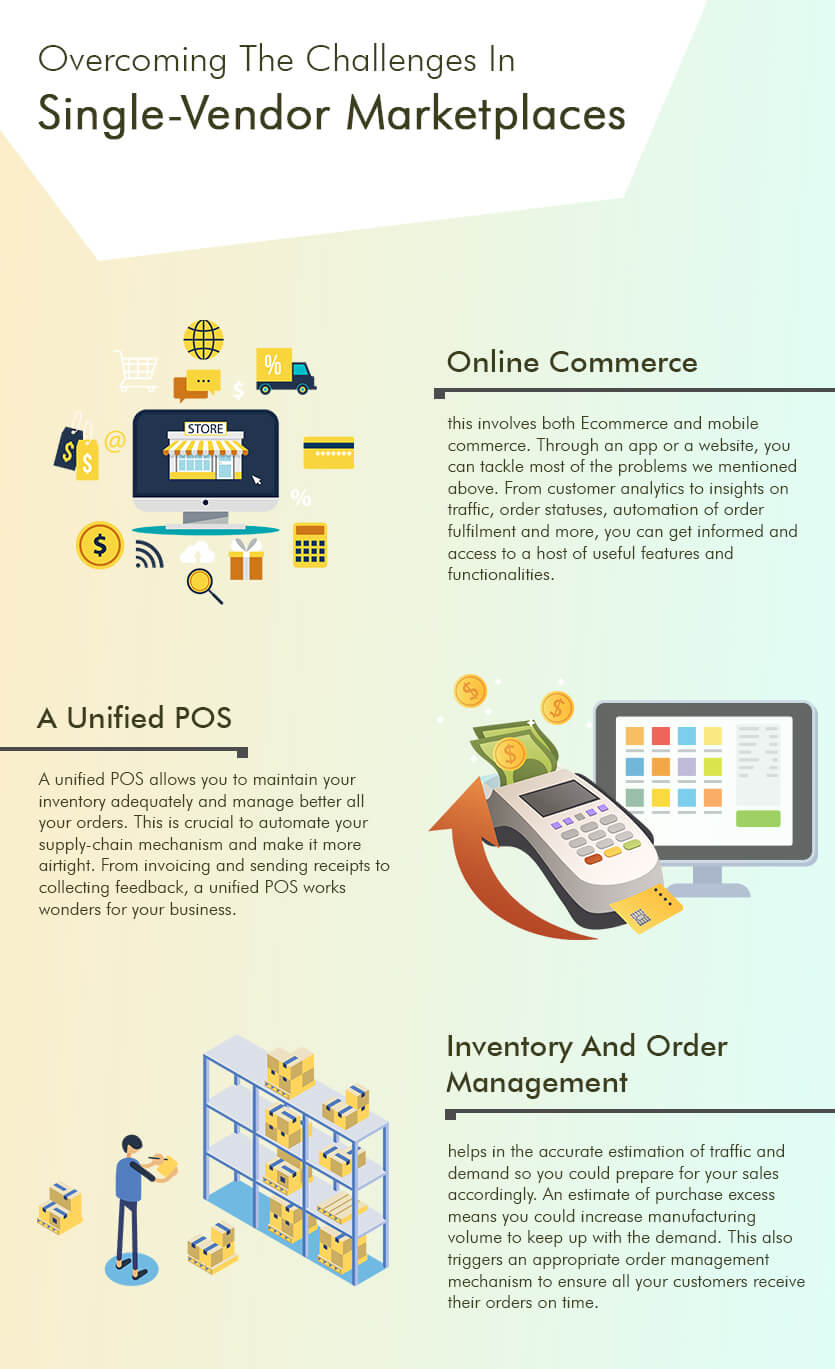
Overcoming The Challenges In Single-Vendor Marketplaces
Online Commerce : this involves both Ecommerce and mobile commerce. Through an app or a website, you can tackle most of the problems we mentioned above. From customer analytics to insights on traffic, order statuses, automation of order fulfilment and more, you can get informed and access to a host of useful features and functionalities.
A Unified POS : A unified POS allows you to maintain your inventory adequately and manage better all your orders. This is crucial to automate your supply-chain mechanism and make it more airtight. From invoicing and sending receipts to collecting feedback, a unified POS works wonders for your business.
Inventory And Order Management : helps in the accurate estimation of traffic and demand so you could prepare for your sales accordingly. An estimate of purchase excess means you could increase manufacturing volume to keep up with the demand. This also triggers an appropriate order management mechanism to ensure all your customers receive their orders on time.
The market is just right to venture into an online marketplace business. If you share this thought, you should make a wise decision today on this.
And if you are looking for an ideal single-vendor marketplace app or a website, get in touch with us. We work with industry veterans and experts to help your business stand out from the clutter.
Reach out today.

Challenges Faced By Multi-vendor Marketplaces
Like we saw, multi-vendor marketplaces are very different from single-vendor marketplaces in terms of operations, business model and more. So, the challenges they face on a daily basis are very different from other two types of marketplaces as well.
If you’ve wanted to run a multi-vendor marketplace, here are the probable challenges you would face.
Multi-vendor Management : the primary challenge of maintaining good rapport and proper liaison with all your vendors for your marketplace. This becomes increasingly tough when you have one vendor for each specific product in your inventory.
Real-world scenario : let’s assume you have a multi-vendor grocery store and you have separate vendors for pulses, rice, vegetables, fruits, frozen food, cold storage and more, managing each vendor from a supply-chain perspective becomes tedious. You end up spending most of your time figuring out and replenishing your inventory if you have a manual or an obsolete mechanism in place.
Catalog Management : where you need to upload all the products and goods offered by your vendor on to your website. This is really a concern when there are bulk orders with large quantities of different products from multiple vendors. Simultaneously, what becomes difficult is processing the payment of each vendor and maintaining appropriate credit limits if it’s applicable.
Real-world Scenario : Catalog management involves having appropriate images for each product with their right product descriptions, reference IDs, specifications and more apart from their stock details. Also, you should be scheduling discounts for products in your catalog that have remained stagnant in your inventory for long before they perish.
Membership Management : where the memberships of your vendors have to be identified and notified individually for renewal. Independent contracts have to be formulated with each vendor and commissions on every sale have to be processed depending on your payout cycle.
Real-world Scenario : your website’s admin would go through a tough time if your website is not designed to view/edit membership details of all your vendors and if these intricate details are not presented or maintained. Consistent delays in commission payouts could result in the dissolution of collaboration.
Customer Management : also is a crucial challenge faced by multi-vendor stores, where memberships, profiles, accounts and order history of every customer has to be maintained with all the latest updates based on their behavior.
Real-world Scenario : Customer management involves maintenance of crucial confidential information about your customers. A loosely-built website could end up breaching privacy of your customers and fetch you a bad reputation.
Delivery Management : is key in making your business sustainable in the market. Most customers today pay upfront for their products or services to avoid contact with delivery associates. So, they expect prompt delivery of their products. Any loophole in delivery management could end up in delayed deliveries or delivery of wrong items.
Real-world Scenario : Without a proper estimation of when an item would be dispatched and shipped, customers would be left in the dark about their deliveries. And this estimate should be based on the credibility of your vendor and their order fulfillment ratios.
Quality Maintenance : from a customer’s perspective, how their products arrive, when they arrive, their engagement, refund policies and more are not your vendor’s problem but yours. This is because you are the intermediary who promises all good things. So, quality maintenance is on you.
Real-world Scenario : frequent audits of products, mock deliveries, vendor rating systems, airtight refund/returns policy and more should be implemented if you intend to stay as a quality marketplace business.
Chicken-Egg Problem : a classic where there needs to be a fine line between the availability of customers and the availability of adequate number of vendors to supply the required quantities of products and services.
Real-world Scenario : if your customer base is less but there are more vendors, you would end up having overstocked items in your inventory and find new ways to push sales. On the other hand, if you have less vendors but more orders, you would have disappointed customers as they wouldn’t receive their products or services on time.
Product Search And Filtering : your visitors would convert to customers only if they find what they are looking for. And this search on your website should be as seamless as possible. The harder it is for your customers to navigate through your website and products listings, the easier it will be for them to abandon your marketplace.
Real-world Scenario : Most of the time, customers don’t have a particular brand in mind and that’s why multi-vendor marketplaces are such a hit in the market. With your business, they should be able to search for products, compare one or more products, filter according to their needs and finally make that purchase.
Payment Options : where you follow the market trends of accepting all forms of payments from multiple payment gateways. This includes digital wallets, internet banking facilities, credit/debit cards, online payment aggregators and more.
Real-world Scenario : sometimes, customers have a coupon or a very specific digital wallet with money in it they want to use for making purchases. When items have been added to their carts and finally they realize their payment is not accepted, it’s over. Their carts are abandoned and you lose such customers forever.
Reporting And Analytics : is bound to be a challenge especially when there are so many intrinsic and extrinsic operational factors involved. There are multiple vendors, tons of customers, products, invoices, payouts, commissions and more.
Real-world Scenario : analytics is essential where you need to know your top-performing vendors, products, categories and more to make crucial business decisions. Knowing the positives about your business would help you scale up and knowing details on cart abandonment, ghosted customers, frequent product returns and more would help you know how to cut down on your losses.
Overcoming The Challenges In Multi-vendor Marketplaces
.jpg)
Business Intelligence : your website along with its three types of profiles – admin, customer, and owner – are treasure-chests of information. There are multiple data touchpoints that offer you game-changing insights you never existed before. Implementing a good analytics or business intelligence mechanism will help you grow your business in ways unimaginable and fight all the concerns we mentioned in reporting and analytics challenges.
Multiple Payment Gateway : is one ideal solution to retain customers as you offer them the liberty to make a payment of their choice for products of their choice. Customers enjoy such liberty and when you have even the most recently launched payment systems or aggregators on board, you end up developing a very tight loyal group of customers for your business.
Smart Search And Recommendation : the advantage of online shopping lies in the fact that a system can understand a customer way better than any salesperson could ever do. With your search and transaction history, previous purchases, interests and preferences, presenting customers with the right products at right budgets is a masterstroke to win them over. The entire concept of smart search is to forecast what they are likely to buy based on their preferences and present them with such products soon so they buy them immediately and move on to purchase more products.
Supply-chain Management : Business intelligence can be applied to supply-chain management, too. In this, you could predict and replenish products that are more likely to get sold out soon and order in less numbers products that have been stagnant for a while. The entire process of inventory management and ordering can be automated with a few lines of code.
Interactive Marketing : is where all creativity and magic happen. Through lead nurture email sequences, gamification, videos, personalized advertisements and more, you lure your customers even more and carve a niche for your brand in the market. Interactive marketing not only helps you in understanding your customers better but pave the way for increased customer retention and acquisitions as well.
Peer-to-Peer Commerce
.jpg)
If multi-vendor marketplaces are different from single-vendor marketplaces, peer-to-peer marketplaces are a completely different ball game altogether. Also known as C2C or customer-to-customer marketplace, this business entirely functions without a vendor.
Here, customers who intend to sell their products or services are vendors and those who seek them are buyers. A P2P marketplace could be a platform for products like pre-owned goods or for services like freelance marketplaces, education marketplaces and more.
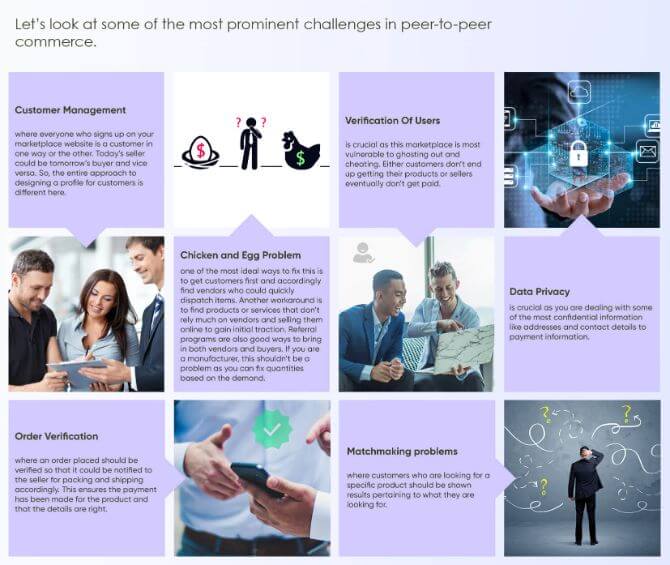
The challenges in this are very distinct and specific to its market segment. Let’s look at some of the most prominent challenges in peer-to-peer commerce.
Customer Management : where everyone who signs up on your marketplace website is a customer in one way or the other. Today’s seller could be tomorrow’s buyer and vice versa. So, the entire approach to designing a profile for customers is different here.
Real-world Management : Customer profiles don’t work like the ones in conventional marketplaces. Sellers don’t have a warehouse or a supply-chain mechanism as such. They have a product they intend to sell. That’s all. So, it’s tricky until a product and the payment reaches both the parties involved.
Chicken and Egg Problem : one of the most ideal ways to fix this is to get customers first and accordingly find vendors who could quickly dispatch items. Another workaround is to find products or services that don’t rely much on vendors and selling them online to gain initial traction. Referral programs are also good ways to bring in both vendors and buyers. If you are a manufacturer, this shouldn’t be a problem as you can fix quantities based on the demand.
Verification Of Users : is crucial as this marketplace is most vulnerable to ghosting out and cheating. Either customers don’t end up getting their products or sellers eventually don’t get paid.
Real-world Scenario : your business should have proper payment locking features or assurance policies like Escrow methods that protect the liabilities of both customers and sellers. Without this, your entire venture would appear like a scam.
Data Privacy : is crucial as you are dealing with some of the most confidential information like addresses and contact details to payment information.
Real-world Scenario : the delivery addresses, items purchases, product details and everything should be discrete. In cases of freelance marketplaces, outsourcing of work from bigger corporate companies happen which have their own layers of confidentiality. Your system must be airtight and resistant to vulnerabilities.
Order Verification : where an order placed should be verified so that it could be notified to the seller for packing and shipping accordingly. This ensures the payment has been made for the product and that the details are right.
Real-world Scenario : Oftentimes, people simply order products from sellers and cancel them resulting in losses to sellers. Since sellers are common people who just want money for the product they have, order verification plays a crucial role in ensuring their saving of time, money and efforts.
Matchmaking problems : where customers who are looking for a specific product should be shown results pertaining to what they are looking for.
Real-world Scenario : imagine customers looking for hair trimmers and your algorithm redirects them to lawn mowers.
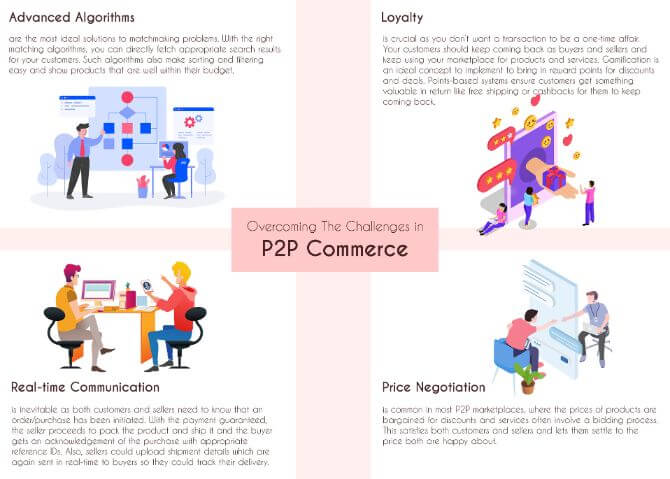
Overcoming The Challenges in P2P Commerce
Advanced Algorithms : are the most ideal solutions to matchmaking problems. With the right matching algorithms, you can directly fetch appropriate search results for your customers. Such algorithms also make sorting and filtering easy and show products that are well within their budget, specifications, years of use and other parameters.
Real-time Communication : is inevitable as both customers and sellers need to know that an order/purchase has been initiated. With the payment guaranteed, the seller proceeds to pack the product and ship it and the buyer gets an acknowledgement of the purchase with appropriate reference IDs. Also, sellers could upload shipment details which are again sent in real-time to buyers so they could track their delivery.
Price Negotiation : is common in most P2P marketplaces, where the prices of products are bargained for discounts and services often involve a bidding process. This satisfies both customers and sellers and lets them settle to the price both are happy about.
Loyalty : is crucial as you don’t want a transaction to be a one-time affair. Your customers should keep coming back as buyers and sellers and keep using your marketplace for products and services. Gamification is an ideal concept to implement to bring in reward points for discounts and deals. Points-based systems ensure customers get something valuable in return like free shipping or cashbacks for them to keep coming back.
Future of Online Marketplaces
.jpg)
This sector is growing by leaps and bounds as we speak and a lot of tech innovators out there in the Valley and around the world are coming up with interesting algorithms and updates to make online marketplaces more reliable and functional.
From our experience and perspective, the future of online marketplaces is the integration of disruptive technologies like Augmented Reality (AR) and Virtual Reality (VR). Both have been underrated technologies that are yet to see the light of the day.
AR is perfectly suited for interactive marketing – imagine Pokemon Go – and VR could just boost conversions of apparel and jewelry industries, where customers would be able to virtually try on their preferred products from their home and make a purchase.
Besides these, chatbots to handle complex queries, initiate returns and refunds and more could be deployed in the coming months and years. With the rise of home assistants, voice search will define the future where searches and search results could be triggered through dictation. This will be a game changer where several marketing conventions will be rewritten.